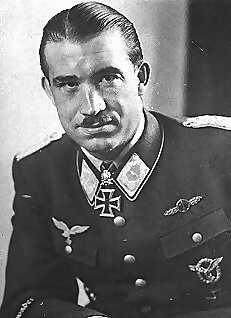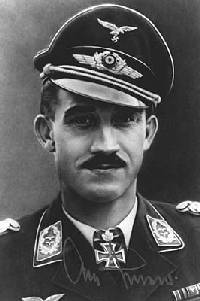
"Only the spirit of attack, born in a brave heart, will bring success to any fighter aircraft, no matter how highly developed it may be." "An excellent weapon and luck had been on my side. To be successful the best fighter pilot needs both. " .... Adolf Galland
|
The
New York Times (February 14, 1996) by David Binder Just before sunrise on Sept 1, 1939, minutes after the first shots of World War II were fired by invading German troops, a 27-year-old Luftwaffe pilot began dropping bombs from his Henschel 123 biplane on Polish infantry positions near the frontier town on Panki. On April 26, 1945, two weeks before the end of the war, the same pilot, flying his last mission in a small formation of Messerschmitt 262’s - the world’s first jet combat fighter - downed a two-engined Marauder bomber over the Danube. Over those four and a half years of fighting, that pilot, Adolf Galland, shot down 104 Allied planes, making him one of the top fighter aces of the war and one of a handful to have survived combat. General Galland died after a long illness on Friday at his home in the Rhineland town of Oberwinter. He was 83. As a schoolboy in Westphalia, Adolf Galland developed a passion for avaition. From building model planes he went to gliding, the only form of flying then legally allowed for Germans under the Versailles Treaty that ended World War I. In the early 1930’s, his gliding expertise smoothed his way into the embryonic and illegal Luftwaffe, in whose rise and fall he played a central role. He flew combat missions during the Spanish Civil War in support of the rebel forces of Gen. Francisco Franco. During World War II he flew warplanes in the conquest of Poland, the invasion of France, the Battle of Britain and the final defense of the Third Reich. Along the way, he tangled over tactics and strategy with his commander, Hermann Goring, and with Hitler. But he seems never to have expressed remorse for serving a German war machine that brought death to tens of millions. From the outset his goals were to fly, to fight and to win. He started out the war as a first lieutenant and ended it as a lieutenant general commanding a jet fighter unit. In July 1944 he held the higher rand lf General of Fighter Pilots. But he protested when Hitler ordered his carefully constructed strategic fighter reserve of 800 aircraft into battle against the Allied invasion front in northern France, where they were swiftly chewed up. "At this moment I lost all spirit for the further conduct of hostilities", General Galland wrote in his memoir, "The First and the Last". A month later he accompanied Albert Speer, the Minister of Armaments, to the Wolf’s Lair in East Prussia, where Mr. Speer, inspired by General Galland, urged Hitler to concentrate efforts on air defense of the Reich, with emphasis on increased fighter production. Germany was then being pounded daily by Allied bomber raids. Enraged, Hitler ordered the two from his bunker and General Galland was demoted for “insubordination”, he recounted in his memoir. Captured in May, 1945 by American forces at an airbase in Salzburg, Austria, General Galland was briefly transferred to the British, several of whose offices knew him from captivity as war prisoners, for interogation by a famed British Spitfire pilot, Wing Commander Robert Stanford-Tuck. It was a renunion of sorts, for the Wing Commander had crash-landed near Boulogne in occupied France in 1942 and as a prisoner of war was given a lavish dinner by Galland, then a lieutenant colonel. Returning the courtesy to the captured German officer, Mr. Stanford-Tuck recalled, “Mostly we just fed him cigars and wine and, you know, just talked.” General Galland remained a prisoner for two years, a normal stint. Years after the war, the two fliers went grouse hunting together in Britain. Wing Commander Stanford-Tuck died in 1987. Adolf Joseph Ferdinand Galland was born March 19, 1912 in Westerholt, one of three sons of a minor Westphalian moblenam’s estate overseer. He made his first glider flight in 1927, soon became a champion glider pilot, and earned admission to Lufthansa’s pilot training center at Braunschweig. In February 1935 he entered the Luftwaffe for still-secret combat training, disguised as a civilian pilot, and was performing stunts when he crashed that year, smashing his nose and damaging his left eye. “Unfit for flying” his medical report stated after three months of treatment. He crashed a second plane, but after memorizing the eyechart letters with the help of another officer he was again passed for Luftwaffe duty. When civil war broke out in Spain in the summer of 1936 Lieutenant Galland volunteered for the Condor Legion, a semi-secret German military detachment formed by Hitler to aid Franco. He was given command of a squadron of outmoded Heinkel 51 fighters and over the next year he flew 300 sorties against Spanish Republican forces. In the summer of 1939, Lieutenant Galland was dismayed to find himself posted to the Polish frontier, flying the sluggish Henschel ground support plane. He flew 50 uneventful sorties. Half a year later, he got the mission of his dreams: flying the new Messerschmitt 109E. On May 12, 1940, over Liege, he made his first kills, shooting down two Hawker Hurricanes flown by Belgians. Two weeks later he shot down his first Supermarine Spitfire over Dunkirk, where the British Expeditionary Force was in the midst of its desperate evacuation. The following week, he shot down two French Morane fighters. In July, he entered the Battle of Britain, flying two to three sorties a day escorting bombers and engaging in dogfights with Spitfires and Hurricanes of the Royal Air Force. In August 1940, at the peak of the sky battles over London, Marshall Goring visited an airbase on the Channel coast and poured abuse on the fighter pilots for failing the defeat the R.A.F. He asked Lieutenant Galland what his fighter wing needed. "I should like an outfit of Spitfires for my group", he replied, leaving Goring speechless with rage. For another year he continued to fly missions from bases in France, racking up more and more victories. By Christmas 1941 he had been promoted to major general, the youngest in the German forces, with the title General of the Fighter Arm. For the time being his flying days were all but over. Still, in autumn 1943, against orders, he flew a new Focke-Wulf 190 from a field near Berlin to meet a large formation of American bombers and shot one down. He did this again in the spring of 1944, shooting down a B-17 near Magdeburg. But this time he found himself pursued by four North American P-51 Mustang escorts and made a very narrow escape. In December 1944, with the Red Army advancing on Germany, Hitler diverted the bulk of the Luftwaffe’s fighters to support his offensive against the United States Army in the Ardennes, the Battle of the Bulge. Three hundred fighter pilots were lost in this hopeless offensive. It was not the final defense of the Third Reich General Galland had intended. Although he had fallen out of favor with the German high command, General Galland was allowed by Hitler to fly the Me-262 jet fighter. The two-engined plane flew 520 miles an hour, much faster than any piston-engined aircraft. By his account production of the jet fighter was delayed at least 18 months by Hitler himself. But when if finally came on line Hitler said he wanted the jet to be re-configured as a bomber to be used in retaliation for the massive Allied air raids. "One might as well have given orders to call a horse a cow", General Galland commented. The Me-262 went into action in October 1944 and scored instantly against Allied air fleets. In January 1945, General Galland was entrusted with forming Fighter Unit 44 with the new jets at Munich’s Reim airbase. But it was much too late. Allied planes were raiding their airfield daily. Following discharge as an American prisoner in 1947, he went on to a successful career as an international aviation consultant, first with the Argentine Air Force for seven years, and then in Germany. Survivors include his third wife, the former Heidi Horn, a son, Andreas, a daughter Alexandra Isabelle, and one grandchild. |
Click here for information on the Bf 109

Galland's Bf 109-E4


